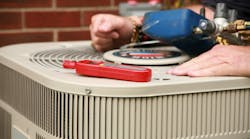HVAC service companies across the country repeat the pattern of test, diagnose, and repair as they work to bring comfort to their customers. Let's take a closer look at this three-step approach to problem solving and how you too can use it to better serve your customers.
Help Me, Please!
When a customer contacts your office to request help, very few have any understanding about the repairs necessary to solve their problems.
An exact survey of words your customers use when describing what is wrong with their equipment, would show just how unfamiliar they are. Phrases like "It's not working," "Nothing's happening," "I'm cold," "I'm hot," and "I need your help" may be five most frequent pleas for help.
All they can really communicate is that something is wrong and they need your help. The rest is up to you.
The First Test - Ask Questions
Your first test is to gather information by asking a few questions about what they are experiencing. While customers don't know what it means, your expertise will hopefully make sense of their observations.
Many of you may be in the habit of bypassing this important step. This is a mistake. The answers to your questions can provide tips and clues that direct you to the solution. This conversation also lets your customer feel they have been heard. That makes them feel like they're involved in the outcome. By skipping this step, you risk failing to communicate effectively. That certainly can put you into a precarious situation.
The Second Test - Inspect
I haven't met a blind service tech during my career. But I have seen many who blow past the inspection test, thinking they already have the problem figured out.
Stop and take time to inspect -- every time. If you think about it, you've had many moments where you found a problem through inspection, maybe something unique that you never encountered before. Think and look inside and outside the box.
The Third Test - Startup the System
This is where most techs get comfortable. You begin to gather information at a stellar rate as you observe the sequence of operation and see what does and doesn't function as it should.
The Fourth Test - Use Your Instruments
Much of the information you gather to diagnose defects in a system are from elements that are invisible. Electricity, gas, refrigerant, air, pressure, temperatures, flue gases, and system functions are all hidden and can't be seen with your eyes.
Your instruments allow you to "see" the invisible. Use your skills and experience to interpret your readings and compare them to published specifications or industry standards. With the information you've collected from these four basic tests; question, inspect, start-up, and instruments, you're fully prepared to diagnose and identify system problems.
A well-trained technician’s mind launches into diagnosis and troubleshooting the moment they arrive at the job. Data collection is constant as they connect the dots and diagnose the problem.
Diagnostics requires a prescription or scope of work. Without one, you cannot describe the needed repair, price it, and communicate it to your customer.
Making the Sale
Once you complete your testing and diagnostics, form a scope of work, and price the needed repair, only one step remains. Someone must pay for it. Whether you're in a home, a facility, or on a warranty call, somebody usually must agree to authorize the repair. Your ideas need to be sold.
This requires you to draw on a different skill set as you translate what you know about the repair and explain it to your customer in a language they can understand. This is the same person who contacted the office and all they could say is "It's not working."
If you're fortunate, your company uses a very effective flat rate pricing program, including a picture or two and a brief description of the repair you can use to get started.
But then the questions come. Customers want to understand the repairs and know why it's needed before they agree to buy your solution.
Developing the ability to explain your testing, diagnosis, and prescribed repair to your customer may be harder than developing your mad testing and diagnostic skills. Nevertheless, part of every technician’s job is to explain, show, and teach until customers are comfortable enough to authorize the repair.
Repair
Once you've made it this far in the test-diagnose-repair approach, fixing the problem is easy for most of you. You are uniquely qualified to make the repair because of the specialized knowledge you gained by diagnosing and identifying the solution.
Now, Do It Again
You make the repair. But you're not yet done.
You still need to verify that your repairs solved the problem. You do that using the same three-step approach. Hopefully it's much quicker this time.
First, you test again by inspection, startup, and using your instruments to verify the repair did the job.
Second, you diagnose again to verify the repair was successful and no additional system defects exist hidden behind the obvious repair you just made.
Test, diagnose, and repair is a three-step approach common to many professions. Medical professionals, the auto industry, accountants, manufacturers, lawyers, and everyone else who solve customer problems use it.
Hopefully this simple explanation of the three-step problem-solving approach will help you better understand what you do daily. Perhaps it allows you improve how you serve and delight your customers and increase your satisfaction with your profession.
Rob “Doc” Falke serves the industry as president of National Comfort Institute, Inc., an HVAC-based training company and membership organization. If you're an HVAC contractor or technician interested in a free test procedure describing simple airflow testing, contact Doc at [email protected] or call him at 800-633-7058. Go to NCI’s website at nationalcomfortinstitute.com for free information, articles, and downloads.









